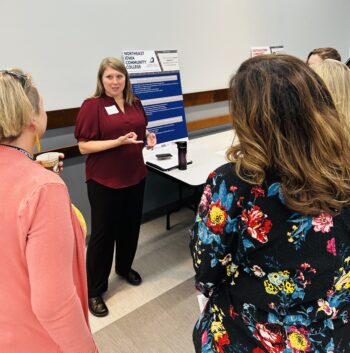Featured Work: Bridging the Non-Credit and Credit Divide in Iowa
Non-credit education and training can be a starting point to students’ journey in postsecondary education; yet community colleges have long erected a barrier between their non-credit and credit divisions, limiting student mobility between the two. In 2020, Education Strategy Group released a report, A More Unified Community College, to assist postsecondary leaders in bridging the divide between their non-credit and credit divisions. Iowa is a national leader in workforce development with major state investments in quality short-term training options through their GAP and PACE programs.
 Looking to build on these assets in the state, Community Colleges for Iowa—a nonprofit, membership association representing Iowa’s 15 community colleges—partnered with ESG to host a series of workshops to support all Iowa community colleges in developing new or improved pathways between non-credit and credit programming. ESG coupled two deep-dive workshops with light-touch technical support to help all community colleges develop and refine robust action plans to align non-credit and credit functions. Each site’s action plan focused on the implementation of high-quality pathways between non-credit and credit, specifically pathways defined as those that:
Looking to build on these assets in the state, Community Colleges for Iowa—a nonprofit, membership association representing Iowa’s 15 community colleges—partnered with ESG to host a series of workshops to support all Iowa community colleges in developing new or improved pathways between non-credit and credit programming. ESG coupled two deep-dive workshops with light-touch technical support to help all community colleges develop and refine robust action plans to align non-credit and credit functions. Each site’s action plan focused on the implementation of high-quality pathways between non-credit and credit, specifically pathways defined as those that:
- Treat non-credit students as equal to credit students;
- Provide automatic or semi-automatic credit determination for non-credit learning experiences;
- Promote the next step on the pathway through clear communication and advising;
- Align operational foundations as demonstrated through joint leadership, shared data systems, and coordinated internal processes; and
- Remove barriers to transitions related to finances, financial aid, registration, and others.
Participating colleges were provided with meaningful spaces to learn from one another and receive insight from peer colleges and national experts. ESG provided technical assistance to institutions, including:
 Distributing and analyzing institutional self-assessment surveys;
Distributing and analyzing institutional self-assessment surveys;- Conducting state-level policy scans to identify existing assets for alignment;
- Hosting office hours for accountability and shared learning;
- Inviting guest speakers to present on best practices;
- Supporting goal setting and action planning;
- Establishing of common language and shared understanding for alignment; and
- Providing action planning templates, tools, and subject matter expertise.
Iowa’s motivation for engaging in this work is to achieve greater equity for their learners — specifically, to address the siloed nature of many traditionally “workforce” and “academic” programs at the college that have a greater impact on racially marginalized and low-income learners. Community college leaders in the state are working to ensure that no learner faces a dead-end. For institutions to sustain or increase enrollment, now is the time for community college leaders to re-examine their non-credit and credit functions and aim to increase alignment between the two. Through detailed non-credit data collection and reporting as well as action plans for alignment, the state of Iowa is well-positioned to lead the nation on this front.



